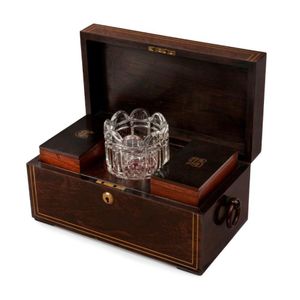Brass Inlaid Rosewood Tea Caddy with Glass Bowl
You must be a subscriber, and be logged in to view price and dealer details.
Subscribe Now to view actual auction price for this item
When you subscribe, you have the option of setting the currency in which to display prices to $Au, $US, $NZ or Stg.
- Rosewood - A dense timber that varies in shade to very light brown to almost black. When rosewood is cut and sanded the colour of the timber will turn black, and after polishing and exposure to daylight, the surface will gradually lighten over time to light brown with black streaks.
The name comes from the odour emanating from the timber when it is planed, sanded or cut.
Rosewood was very popular for use in Victorian furniture in the second half of the 19th century, and at that time most of the rosewood was imported from Brazil. However it also grows in India and Indonesia.
It is used in the sold for chairs and table legs, but for carcase furniture such as side cabinets and bookcases, and for table tops it is always used as a veneer. - Circa - A Latin term meaning 'about', often used in the antique trade to give an approximate date for the piece, usually considered to be five years on either side of the circa year. Thus, circa 1900 means the piece was made about 1900, probably between 1895 and 1905. The expression is sometimes abbreviated to c.1900.
- Regency Period - The Regency period in English furniture design refers to the period when King George III, was declared unfit to rule in 1811, and his son ruled as proxy as Prince Regent, until 1820, and then, after the death of his father as George IV until his death in 1830. The Regency period was preceded by the Georgian period (George I, George II, and George III: 1714 - 1811), and was followed by the William IV period, which only lasted until 1837 when William IV died as was succeeded by Queen Victoria.
This item has been included into following indexes:
- tea caddies, material - rosewood 147
- tea caddies, period or age
Visually similar items

Writing Boxes: Two 19th century amboyna writing slopes. Height 16 cm, width 35 cm, depth 25 cm approx.

A fine Chinese leather and lacquer stationery box, Qing Dynasty, 19th century, with bronze clasp and handles, neatly stitched around the edges, the interior fitted with a tray, height 16 cm, width 28 cm, depth 20 cm

A 19th century tea caddy. Rectangular form, with a hinged top enclosing a mixing bowl and compartments, on bun feet. 18 cm high, 19 cm wide, 15 cm deep.

A hardstone inlaid hardwood portable chest, Guanpixiang, of rectangular form, the hinged domed cover with ruyi head metal fittings lifting to reveal a shallow compartment, above a pair of panelled doors flush within mitred frames opening to reveal two pair
